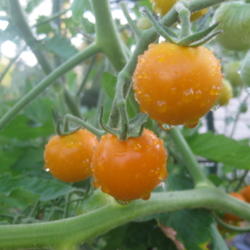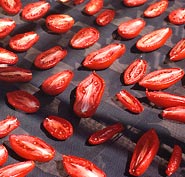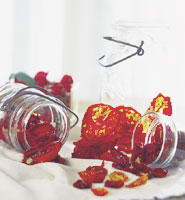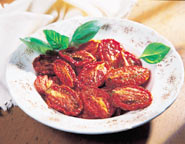
Few pleasures match the satisfaction of tasting summer's fruits long after the season has passed--appreciation seems to increase the further the calendar is from summer. Although the intense aroma and flavor of a tomato just picked from the vine are almost intoxicating, by season's end, dealing with the bounty is almost a burden. After all, there are only so many friends to share the harvest with.
Preserving these garden treasures, an art born of necessity, allows you to extend the season in several ways. Freezing fresh tomatoes is quick and easy, but the defrosted fruit can have a mealy texture. Canning offers easy, economical storage, though the method is anything but simple.
Unlike the temperature extremes essential for freezing and canning, drying tomatoes requires a gentler approach that is both simple and amply rewarding. Drying draws out the fruit's moisture, concentrating its flavor and bringing out its berrylike essence. It can even enhance the taste of less than flavorful fresh tomatoes.
Drying is the oldest preservation method, traditionally requiringonly the sun's energy over several days. The result is chewy, sweet-tart fruit of intense flavor and incredible versatility.
Selecting and Preparing FruitsAny tomato can be dried, but for best results, begin with plum-type tomatoes; they have thick, meaty walls, fewer seeds, and less gel than salad or beefsteak types. Good choices for drying include 'La Roma', the standard for paste; 'San Marzano', prized by Italians for sauce; and 'Principe Borghese', a traditional variety best suited for drying. Vibrant yellow 'Lemon Boy' and bright orange 'Italian Gold' offer colorful variations. Cherry tomatoes, such as 'Sungold' and 'Sweet 100', tend to hold more sugars and acids than other types and are also excellent for drying; the result is piquant candylike fruits.
Choose firm, ripe, unblemished tomatoes; damaged or overripe fruits will spoil easily and cause others to do so, too. It's not necessary to blanch the fruits, but wash them well and pat dry. To ensure even drying, slice fruits as uniformly as possible. Half or quarter plum-type tomatoes lengthwise, and cut cherry tomatoes in half or leave whole. Slice other types 1/2- to 1/4-inch thick, depending on your preference. Expect a pound of fresh fruit to yield a little more than an ounce of dried tomatoes.

This method requires a cooperative climate: a string of dry, sunny days with temperatures in the 90s and low relative humidity (less than 20 percent). Select an area that receives full sun, ideally one that also reflects the sun's rays (such as a paved area or flagstone patio).
Use clean plastic-mesh screens (available from cookware stores); metal wire may react with the acid in tomatoes to produce an off-flavor. Place the cut tomatoes in a single layer, allowing about an inch of space between the pieces for air circulation. Place a layer of cheesecloth on the fruits as a barrier against insects and birds, and set the trays at least a foot above the ground so air circulates freely underneath them. Bring the trays indoors each evening and if rain is forecast. Depending on their thickness, moisture content, and the weather, the tomatoes should dry to a leathery but soft consistency in three days to a week.
Easy Oven-DryingThe most convenient drying option, especially if you are not ready to invest in a dehydrator, is using a traditional gas or electric oven on the lowest temperature setting. If your oven can't be set below 150° F, slow-roasting (see below) will yield similarly tasty results. Oven-drying takes 6 to 12 hours, depending on the temperature and the fruits' size and moisture content. It's important to remove as much moisture as possible without allowing the fruits to dry completely, because the lower the moisture content, the longer the tomatoes can be stored safely. Dried fruits should be leathery and pliable.
Preheat the oven to 140° to 145° F Place the prepared fruits skin side down on a plastic-mesh screen, or on a baking sheet lined with cooking parchment or a silicon baking mat. Prop the oven door open slightly to allow the moist, hot air to escape. Check the tomatoes regularly, and rotate the baking sheet if necessary. Dried fruit should be uniformly dry and pliable but not sticky when cool.
The fruits can also be removed earlier. Although these moister tomatoes must be refrigerated, they have a rich flavor and are ideal for packing in olive oil for up to a week.
Effortless DehydratingFor uniform results, an electric dehydrator or a convection oven that offers a low temperature setting is matchless. Dehydrators have a heating element to produce the moderate temperatures (135° to 140° F) and low humidity critical for proper drying. The best dehydrators include a fan, temperature controls, and a timers. Depending on the model, drying can take 5 to 9 hours, but the results are evenly dried fruits well suited for long-term storage.
Convection ovens that can be set to temperatures of 110° to 140° F work similarly, but have less capacity. To obtain the best results from either appliance, follow the manufacturer's directions.
Never use a microwave oven to dry tomatoes; it can't provide the essential continuous, moderate heat and air circulation.

Allow dried tomatoes to cool completely before storing. To maintain their low moisture content, seal cooled, dried fruits in airtight bags, squeezing out excess air. Store the bags in a cool (60° to 70° F), dry, dark place for up to six months. Dried tomatoes can also be refrigerated in airtight containers for up to eight months or frozen for up to a year.
Use dried tomatoes in pastas, sandwiches, salads, and sauces. Chop or julienne them to accent many dishes. Dried tomatoes can also be rehydrated before use. Cover them in warm water or wine, and soak about 10 minutes, until they soften and plump slightly.

Unlike oven-drying, slow-roasting requires gently cooking the tomatoes until their juices caramelize. It is the perfect technique for gardeners with less time or for those with traditional ovens that don't have very low temperature settings. However, storage time is short: roasted tomatoes keep up to a week in the refrigerator, up to six months in the freezer.
To roast, preheat the oven to 225° F. Arrange the tomatoes cut side up on a baking sheet lined with cooking parchment or a silicon baking mat. For added flavor, lightly dress the tomatoes with olive oil and sprinkle with herbs such as marjoram, thyme, or rosemary, as well as salt and freshly ground black pepper. For a spicy-sweet variation that brings out the tomatoes' berrylike flavor, drizzle flavored oil (such as lemon or orange) on the slices, and dust lightly with granulated sugar and cayenne pepper.
Slow-roasting takes 2 to 4 hours, but the fruits will remain very soft and moist. Allow them to cool completely before packing in a clean, airtight container and refrigerating. Roasted tomatoes are delicious in sandwiches and pastas, slipped into soups, and mashed into potatoes.
What About Canning?Canning requires a significant commitment of time and energy, but if you have a large crop of tomatoes, it may be the best way to preserve them. The investment of labor and material offers unbeatable dividends: economical long-term storage and a reminder of summer at a moment's notice.
The canning process requires preparing and hot-packing tomatoes in a canning jar and sealing it with a special two-piece vacuum lid, then processing the jars in boiling water to destroy harmful microorganisms. Before beginning, consult a reputable guide that incorporates current information about safe, healthful preservation. Here are three excellent resources:
* The USDA Complete Guide to Home Canning (USDA, 1994; $20) is also available free on this Web site: www.uga.edu/nchfp/publications/usda/can_guide_order.html.
* Ball Blue Book:Guide to Home Canning, Freezing, and Dehydration (Alltrista Corp., 1997; $5). For answers to canning questions, call the company's hotline: (800) 240-3340.
* "Home Canning Online" (www.home-canning.com), sponsored by Ball, includes an online magazine, tips, product information, and links to other sites.
Shila Patel is a former managing editor at National Gardening.
Photography by Bill Lorenz and National Gardening Association.
 Victory Seed Company has all the seeds you want for your best garden in 2024.
Victory Seed Company has all the seeds you want for your best garden in 2024.
For 25 years, the family-owned Victory Seed Company has provided the highest quality vegetable, herb and flower seeds to families across the country. We are passionate about providing you the best seeds available that give excellent germination, robust plants, and the harvest you want. With a catalog of over a thousand varieties, we have everything, and our prices are the kinds that we'd want to pay. We have hundreds of yesterday's heirloom vegetables, as well as today's award winning hybrid selections. Get to know us by visiting our website and browsing through our online vegetable seed catalog.
| 1. Ripening and Harvesting Tomatoes |
| 2. Preserving Tomatoes: Freezing |
| 3. Preserving Tomatoes: Canning |
| 4. Drying Tomatoes ← you're on this article right now |
| 1. Ripening and Harvesting Tomatoes |
| 2. Preserving Tomatoes: Freezing |
| 3. Preserving Tomatoes: Canning |
| 4. Drying Tomatoes ← you're on this article right now |